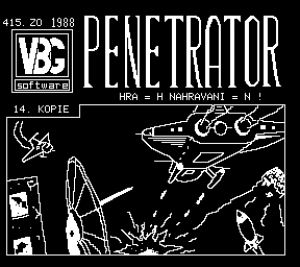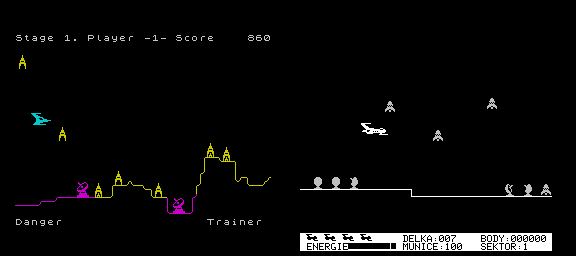From Melbourne House to Czechoslovak Clubs

[ 1 comment ]
Czechoslovakia of the 1980s was a country behind the so-called Iron Curtain. Its economy was in a dire shape and its citizens were either oppressed or annoyed (or both) by its conservative totalitarian regime. It required considerable personal connections to be able to subscribe to a Western magazine or import books and music records; only carefully selected individuals could travel to the West. The country did not have currency reserves to be able to import computers, and the few computers it produced were several years behind Western standards.
But the Iron Curtain wasn’t without holes. Thousands of people ended up owning Western or Japanese 8-bit computers. Some of them were lucky enough to purchase them legally in government-controlled stores with imported goods, others smuggled them into the country or took the advantage of the black market. Pirated copies of software were also flowing into the country through various international networks, often through Yugoslavia or Poland. Thanks to its low price and a large library of software, the Sinclair ZX Spectrum became the most popular machine. Since the Spectrum was a British computer, most games that circulated in the country had come from wherever this platform took root. Most of them from the U.K., but many others from Spain or Australia. And this way, Australian games – predominantly those produced by Beam Software and published by Melbourne House – became some of the most revered titles among Czechoslovak players.
The popularity of Beam Software titles go back to at least 1986. In that year, the Mikrobáze newsletter, run by one of the most prominent Czechoslovak computer clubs, published a listing of software which is available to club members (note that club organizers believed that sharing software within the club is legal and desirable). Among them was The Way of the Exploding Fist (Beam Software 1985). What did the authors of the newsletter have to say about it?
Exploding Fist – kung fu, a martial art similar to karate. You can play against each other or against computer. Perfect execution of animated graphics and a wide selection of movement controls guarantee captivating play and create many comical situations.
Besides the need to explain what “kung fu” means, the description is interesting in how economically it combines evaluation of graphics and gameplay experience, even highlighting the element of emergent comedy.
Another notable mention of Australian games comes from the first Czechoslovak book about computer games, the 1988 “Computer Games: Past and Present” by František Fuka. In this publication, Fuka lists his top 10 action and puzzle games for the Spectrum. In the action category, Melbourne House’s The Way of the Exploding Fist ranked 8th, and The Hobbit (Beam Software 1982) ranked 4th among puzzle games (a category which included text adventures). The other 18 titles were exclusively British.
Fuka goes on to discuss Australian titles in more detail. He considers Philip Mitchell and Veronika Megler’s The Hobbit* “the first great event in the history of text adventures”. He lists four points which the game excelled in: a large vocabulary, “pseudo-intelligent” characters, a sophisticated interpreter and good graphics. Fuka however says that The Hobbit had been bested by other games, especially those by the British company Level 9. To demonstrate The Hobbit’s flaws, he mentions numerous bugs – like being able to kill a wooden chest. He points out similar bugs in Mitchell’s later games – the Lord of the Rings (which Fuka considers “unpolished”) and Sherlock. Despite its position on the top 10, Fuka is more generous towards The Way of the Exploding Fist, which he calls “the best game of its type”, probably referring to fighting games.
Australian programmers and publishers also deserved their places in the book’s glossary. The entry for “Mitchell, Philip”, says that he is “renowned mostly for his games Hobbit and Sherlock. He is also the author of Penetrator. The founding member of Melbourne House.” Of Melbourne House, we read: “A once famous company (Penetrator, Hobbit), now a part of Mastertronic.” Melbourne House was acquired by Mastertronic in 1988, the same year in which Fuka’s book came out. Here, we can see that despite committing some factual errors (Mitchell wasn’t a “founding” member of Melbourne House), the then 20-year-old Fuka had considerable knowledge of computer gaming news, probably through British magazines, which were extremely difficult to get in Czechoslovakia, but which sometimes circulated in computer clubs ¬– usually in one badly worn copy.
Fuka’s attitude towards Beam Software’s titles can be indicative of the reception these games had in the whole country, especially because he was a very influential figure on the scene, both as a writer and a programmer. As a player active in the early 1990s, I can attest that Exploding Fist was still a respected title. However, it is quite likely that an average Czechoslovak computer owner would not rank The Hobbit as high, simply because relatively few people could read English. Fuka’s English skills were an exception rather than a rule.
What is missing in the book is a discussion of Penetrator (Beam Software 1982). The existence of this shoot ’em up is repeatedly mentioned, but the game does not get any more attention, perhaps because it was already considered dated in 1988. However, in the same year, the title was revived thanks to a group of hobby programmers from the city of Ostrava. VBG software, a collective which included Vlastimil Veselý, Libor Bedrlík and Ladislav Gavar, produced a conversion (or rather, a remake) of Penetrator for the Czechoslovak computer PMD 85, a machine that was never sold to individual customers, but became widespread in schools and computer clubs.
VBG Software’s Penetrator (screenshot on the right) shows how loosely unofficial conversions approached the original designs they were based on. It is not surprising that the title screen is different. But there are more, rather significant changes. Not only that the player’s fighter plane is larger in the 1989 Penetrator, but the game is also much faster. This results in the fact that an average player has to brake almost all the time in order not to collide with enemy missiles – which was not the case in the original game. On the other hand, the terrain is flatter and therefore not as much of an obstacle as in the original game. Bombs are no longer as useful, because you cannot drop two bombs simultaneously, which you could in Mitchell’s version. The efficiency of the front cannon is compromised due to the introduction of limited ammunition. VBG Software also added a completely new feature: the energy bar. The plane’s fuel is running out and you must land and recharge at least once per stage. So while the original Penetrator’s gameplay was to a large extent based on carefully maneuvering obstacles and timing the deployment of bombs, VBG Software’s game mixes a much more frantic action with resource management. Because of all of these differences, it is problematic to talk about two versions of the same game. Despite surface similarities and some shared mechanics, the gameplay experience is very different. However, the very existence of the Czechoslovak version attests to the popularity of the original, which most likely contributed to the VBG Software’s decision to remake this particular title.
We have seen that the connection between Australian and Czechoslovak game cultures was significant and productive. In all likelihood, it would have not been possible without the existence of Melbourne House’s UK publishing branch, as Britain was the country where most Spectrum games circulating in Czechoslovakia were published. At the same time, we can expect that Melbourne House-published titles found their audiences in other countries similarly connected to the British market. I believe, for instance, that a hypothetical crowdfunding campaign for an Exploding Fist remake would get attention from many parts of Western, Central and Eastern Europe.
*Fuka does not credit co-creator Veronika Megler, who had left Beam Software before the game was published and is rarely featured in the marketing and reviews of the era.


Penetrator was the first game I got addicted to as a kid on our family Dick Smith System 80.
I even still have a System 80 in all its original packaging hidden in the garage. Might even be a copy of Penetrator in there somewhere on tape.